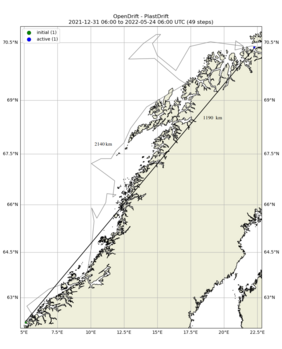We kicked off our “Plastics in the Sea” campaign on the first week of January. The aim of the campaign was to highlight what happens to plastic litter, once it hits the sea, how far it will travel. Rather than adding to the problem itself, sending off actual litter in sea with GPS locators, as has been done earlier, we wanted to do this litter free. Norwegian Meteorological Institute (MET) has developed Open Drift modeling programme, which can be used to simulate transport and fate of different kind of particles, all the way from micro plastics and droplets of oil to ships and icebergs. We created four different scenarios, all of which were originating close to the locations of the POPCORN project partners. And the first one was the case of plastic bottle, which started off from the west coast of Norway, not far away from MET’s offices in Bergen.
This virtual plastic bottle fell overboard/was thrown overboard from a Hurtigruten boat on the morning of New Year’s Eve, as the boat is travelling on the west coast of Norway, between Måloy and Torvik. It was just one bottle out of a million bottles, which annually end up in the sea. In the Nordic countries we have a good deposit bottle system in place, but some bottles and cans do not end up in the return machines, where they should.
Our virtual bottle started on New Year’s Eve a five-month long journey, which we have been following every four weeks. Storm winds have been recorded during this period, sometimes the currents have pushed the bottle into a dead end, into a fjord, from where the bottle did not seem to be able to get out to the sea on its own. We have had to resort to a bit creativity, storytelling during this journey, in order to keep the bottle in motion. Therefore, for the final simulation, which covers the whole journey of the bottle, we have changed the starting point a little from the original one from 31st of December, in order to offer you a more exciting ride, which does not get sidetracked. There is no local fisherman in this final story, who picks up the bottle from a shore of a fjord, but then drops it accidently in to the sea and the currents take it back to the open sea and on a northbound course. The final simulation is just a demonstration about, what could happen to a bottle, which hits the sea at a certain point of the west coast of Norway, and where does it end up in the following months.
And where did it end up then, how far can a plastic bottle drift? Well, they can travel far, as our case demonstrates. In 145 days, between 31.12.21 to 24.5.22, the virtual bottle travelled over 2100 km and ended up almost 1200 km away from its starting point. It did not quite reach the North Cape, but was just about 40 km away from Hammerfest. From 62 degrees north (62.14 N and 5.12 E to be precise) to over 70 degrees north (and 22 E) in 145 days. We are not talking about fast speed here, rather slow travel, about 0,6 km per hour on average. But the overall distance covered is still impressive. And since it can take several hundreds of years for a plastic bottle to degrade (let’s say for instance 200 years, which is 73 000 days), we would have witnessed only the very beginning of the sea journey of this plastic bottle. And as the plastic bottle degrades gradually in the sea and continues its journey, it will release micro plastics, which can end up in the food chain and eventually on our plates. So let’s cut the life of the plastic bottles short and dispose of them accordingly, once the last drop has been drunk… If recycled properly, the bottle can be given a new life, it won't just degrade in the nature.

